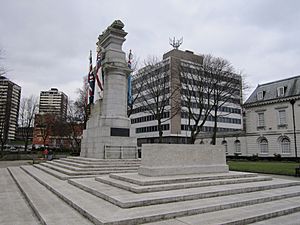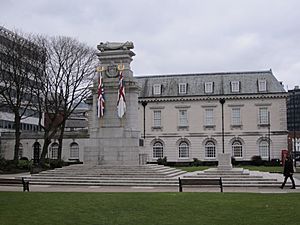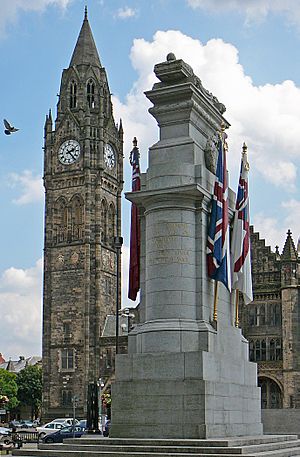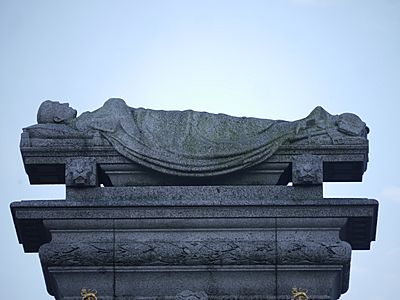Rochdale Cenotaph facts for kids
Quick facts for kids Rochdale Cenotaph |
|
|---|---|
| United Kingdom | |
 |
|
| For servicemen from Rochdale killed in the First World War | |
| Unveiled | 1922 |
| Location | 53°36′58″N 2°09′35″W / 53.616238°N 2.159743°W Rochdale town centre, Greater Manchester, England
|
| Designed by | Sir Edwin Lutyens |
|
TO THE MEMORY OF THE MEN OF ROCHDALE WHO GAVE THEIR LIVES IN THE GREAT WAR / THEY WERE A WALL UNTO US BOTH BY NIGHT AND BY DAY
|
|
|
Listed Building – Grade I
|
|
| Official name | Rochdale Cenotaph |
| Designated | 12 February 1985 |
| Reference no. | 1084274 |
The Rochdale Cenotaph is a special monument in Rochdale, Greater Manchester, England. It was built to remember the brave soldiers from Rochdale who lost their lives in the First World War. This memorial was designed by a famous architect named Sir Edwin Lutyens.
It's one of seven memorials in England that look like his most famous design, The Cenotaph in London. The Rochdale Cenotaph was officially revealed in 1922. It has a tall stone tower, about 10 meters (33 feet) high, with a statue of a sleeping soldier on top. Next to it is a large stone called the Stone of Remembrance.
After the First World War, many towns wanted to remember their fallen soldiers. In 1919, people in Rochdale decided to build a monument. They chose Sir Edwin Lutyens to design it. He first planned a bridge over the River Roch, but then a local leader donated land near Rochdale Town Hall. Lutyens changed his design for this new spot. The memorial was unveiled on November 26, 1922. Today, it is a very important historical building, known as a Grade I listed building.
Contents
Why Was the Memorial Built?
After the First World War, many soldiers died. Towns all over Britain built memorials to remember them. In Rochdale, the mayor held a meeting in February 1919. This was just three months after the war ended.
People decided Rochdale needed a monument. They also wanted to create a fund. This fund would help wounded soldiers and their families. It would also support the families of the 2,000 soldiers from Rochdale who died. People donated money, raising over £29,000. The memorial itself cost about £12,611.
Who Designed the Cenotaph?
At the 1919 meeting, everyone agreed to hire Sir Edwin Lutyens. He was a very well-known architect in Britain. Before the war, he designed large country homes. But the war changed his focus.
From 1917, he spent much of his time designing war memorials. He created the famous The Cenotaph in London. This monument is now the main place for national Remembrance Sunday events. He also designed the Thiepval Memorial to the Missing in France. Lutyens designed many other memorials in Britain and other countries.
Lutyens first suggested a memorial bridge over the River Roch. This river used to flow openly through Rochdale town centre. His plan included statues of soldiers and a Stone of Remembrance on the bridge. But this idea changed. A former mayor, Alderman William Cunliffe, bought an old house nearby. He donated this land for the memorial. This spot was special because the house had been a recruiting station during the war.
Lutyens then designed a new plan. He decided to remove the old house. In its place, he put the cenotaph and the Stone of Remembrance. The Stone of Remembrance is a special design Lutyens used in many war cemeteries. Rochdale's cenotaph is one of his most impressive designs.
What Does the Memorial Look Like?
The Rochdale Cenotaph was built by Hobson Limited. Unlike some memorials with many sculptures, this one uses simple, strong shapes. These shapes are inspired by old classical architecture. The memorial has two main parts. There is a tall stone tower, called a pylon, and a Stone of Remembrance. Both are made from light grey granite stone. They stand on a platform with three steps.
The pylon is about 10 meters (33 feet) tall. It has several levels that get smaller as they go up. On the lowest level, there are four carved stone flags. They are painted and have bronze poles. On one side, you can see the Union Flag and the White Ensign. On the other side are the Royal Air Force Ensign and the Red Ensign. These flags surround a smaller section. At the very top is a sculpture of a soldier lying down, covered by his coat. This pylon design is similar to another memorial Lutyens designed in Derby.
The memorial is not a true cenotaph, which means "empty tomb." This is because it has a figure of a soldier on top. But by placing the soldier high up, Lutyens makes him represent all fallen soldiers. This allows people to feel their own emotions when they see it. Above the flags, there are carved wreaths. These wreaths surround Rochdale's coat of arms.
The central part of the monument has gold writing. It says: "1914–1919 / 1939–1945; TO THE MEMORY OF THE MEN OF ROCHDALE WHO GAVE THEIR LIVES IN THE GREAT WAR." It also has a quote from the Bible: "THEY WERE A WALL UNTO US BOTH BY NIGHT AND BY DAY."
The Stone of Remembrance is next to the pylon. It also stands on three steps. On this stone, it says: "THEIR NAME LIVETH FOR EVERMORE." Later, more words were added to remember those who died in the Second World War. There is a bronze plaque that says: "TO ALL THOSE WHO DIED / IN THE / SERVICE OF THEIR COUNTRY." The gardens around the memorial are also special. They remember soldiers from the Lancashire Fusiliers and the Royal Regiment of Fusiliers.
History of the Memorial
The Rochdale Cenotaph was officially opened on Sunday, November 26, 1922. Edward Stanley, 17th Earl of Derby, led the ceremony. The Archdeacon of Rochdale gave a special blessing. Lord Derby came from a well-known family in Lancashire. He held important government jobs during the First World War. He was even Britain's ambassador to France. Two years later, he also opened the Manchester Cenotaph, another memorial designed by Lutyens.
The Rochdale Cenotaph was first listed as a Grade II building on February 12, 1985. This means it was recognized as a building of "special interest" that should be protected. About 92% of listed buildings in England are Grade II. In November 2015, during the 100th anniversary of the First World War, Lutyens' war memorials were given special recognition. They were called a "national collection."
Because of this, the Rochdale Cenotaph's status was upgraded to Grade I. This is the highest level of protection. Only about 2.5% of listed buildings are Grade I. This means the Rochdale Cenotaph is considered to have "the greatest historic interest."
- Detail of parts of the memorial






